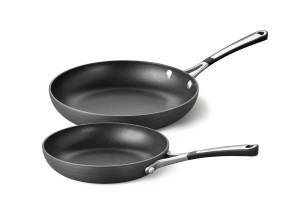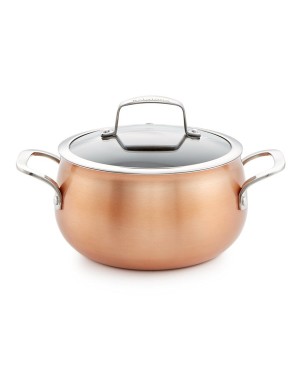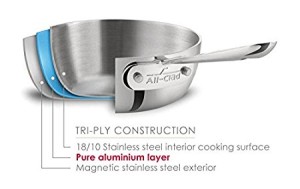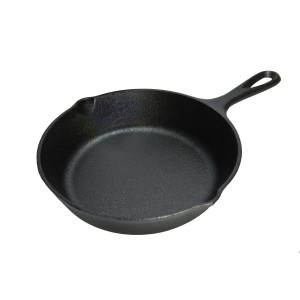When it comes to choosing the material of the pan or casserole, we should be interested in only two things, and this is not the brand of dishes, not what is written on the packaging and not at all what the seller tells about:
1) How evenly the material is able to distribute heat over its surface (its conductivity).
2) How effectively does the material retain heat and transfer it to food located on the surface of the pan (heat capacity and density of the material).
Let’s take a closer look at the features of the materials, dishes are most often made from.
STAINLESS STEEL

“Stainless Steel” – very easy to clean, and as the name implies, it is not subject to corrosion, no matter how severely you use it. But stainless steel is a very poor conductor of heat. This means that heat passes very slowly through it.
Stainless steel pans tend to form hot and cold spots that follow the patterns of flames coming from your gas burner. When cooking some dishes, this can have extremely negative consequences, an omelet, for example, can be burnt in some places, remaining raw in others.
How can I measure the thermal conductivity of your pan?
The easiest way is to sprinkle a thin and evenly thick layer of sugar on its surface, and then put it on the stove and turn on the last one.
Watch how the sugar begins to melt, the places where the sugar melts earlier are hot spots (most likely they are directly above the flames of your stove), while the places where the sugar has not changed its state are cold spots. In a good frying pan, the sugar will melt evenly.
Also, if you suddenly have an infrared kitchen thermometer lying around, you can do the following experiment: put a stainless steel frying pan on the stove and measure the temperature in different parts, if it is approximately equal – the pan is good, if the temperature is different at different points – the conclusion suggests itself.
ALUMINUM
Aluminum is a much better heat conductor. One of the best, actually. In addition, aluminum is an inexpensive material. But the question is: then why all the pans aren’t made of aluminum?
There are a couple of nuances.
Firstly, aluminum is not a very dense material. This means that despite the high conductivity, you will need a pan with a very thick bottom to maintain the required amount of heat.
Secondly, aluminum is being discolored and stained by interaction with acidic ingredients: wine, lemon juice, vinegar, tomatoes, etc.
ANODIZED ALUMINUM

This is the same aluminum that has been processed to give it a ceramic-like surface that is sufficiently non-stick and acid-resistant.
It is an ideal material for cooking the dishes that don’t require extreme temperatures.
Frying a steak in such a pan is not a good idea, but there is no better surface for making eggs.
COPPER
 Remember, I mentioned above that aluminum is one of the best heat conductors. So, copper is an even much more thermally conductive material.
Remember, I mentioned above that aluminum is one of the best heat conductors. So, copper is an even much more thermally conductive material.
Also, copper is quite dense and has excellent heat capacity.
Cons of copper are the price and its pickiness in care.
Probably everyone who enjoys cooking would like to have a set of copper pans in their arsenal, but not everyone can afford it.
THREE LAYER COOKWARE

Three-layer cookware ( straightened bottom, layered, etc.) or tri-ply – incorporates the best qualities of aluminum and stainless steel dishes.
This type of cookware is a sandwich, in which the role of bread is played by stainless steel, and the role of filling is aluminum.
That is, we have three layers of metal here: the two extreme ones are stainless steel and the inside is aluminum.
As a result, we get a symbiosis of high-density stainless steel with amazing heat-conducting properties of aluminum.
NON-STICK COATING COOKWARE

The times when non-stick cookware was worth the recommendations have passed.
A coating that emits harmful gases when it overheats is certainly not the thing that we would like to cook food on.
Yes, today, non-stick cookware has become much safer. But, it did not become multi-purposed.
It is worth having one or two good non-stick pans in the arsenal, for cooking eggs and pancakes, but do not abuse it with using this cookware for cooking dishes that require extremely high temperatures.
CAST IRON COOKWARE

By the ability to retain heat, no other cookware compares to cast iron. Its specific heat capacity is less than aluminum, but due to its much greater density, with the same thickness of the pan, the ability to retain heat is about 2 times higher, and this is important: the pan doesn’t cool down when you add food to it.
Here’s an example: the surface temperature of a thin aluminum pan can drop by 150 degrees when you put a 200-gram steak on it, while the temperature of the cast iron pan will remain at about the same level if the rest is equal.
In practice, this feature of the metal will help to get a crispy and more evenly fried crust.
Cast iron, by the way, feels great in the oven, so you can use the same cookware for frying on a gas stove, and for baking and stewing in the oven. Due to its ability to retain heat, the surface temperature of the pan always remains at approximately the same level, even when the temperature in your oven fluctuates (and this affects most ovens with a thermostat).
Well, at the very end, let’s talk about durability. Cast iron cookware is one of the few things in the kitchen that only gets better over the years. Over time, the surface of frequently used cast iron cookware becomes smooth and comparable in properties to non-stick Teflon surfaces, only without all these harmful chemical compounds.
Of course, cast-iron cookware also has its drawbacks. Now about them:
- Food will stick to the surface until a protective layer is formed. This applies even to the so-called “preseasoned” dishes (the one that doesn’t need to be incinerated and prepared for first use). If you use cast-iron dishes daily, then it takes several weeks to form this layer (sufficiently non-stick is good to cook eggs without any problems). Therefore, if you rarely use it, it may take several months.
- It warms up unevenly. Contrary to the general misconception, cast iron has poor thermal conductivity, which means that heat can’t go far from its source. Try to take a cast-iron frying pan with a diameter of 30 cm and place it on the smallest gas burner, the one used for the cezve: the edges of the pan will never become hot. In order to warm up the cast-iron pan evenly, you need a burner approximately equal in diameter to the pan that you will use. Another way is to preheat cast-iron dishes in the oven, and then move them to the stove.
- It can rust. As long as a sufficient layer of the protective layer is not formed on the surface, careless use, such as over-tearing the pan or wiping it dry before storage, can lead to rust.
- You cannot cook too acidic food in it. Sour foods will absorb the flavor and color of cast iron. The color of the food will become dull and dirty, and the taste will be replenished with a metallic smack.
- It is heavy. Well, there’s nothing you can do. The price of high density and, as a result, heat capacity is a big weight.
- It requires special care. Since the culinary qualities of cast iron utensils directly depend on the protective layer formed on the surface, you must take care of it when cleaning and washing it in order to avoid accidentally removing this layer. Otherwise, you will have to start all over again.
Now, you know a little more about the different materials of kitchen utensils and their features. There will be no specific conclusion here, but in the next part I will talk about the 8 most necessary items of kitchen utensils, there we will analyze what material and pan should be used.
This article is based on material from the book ‘The Food Lab’.
